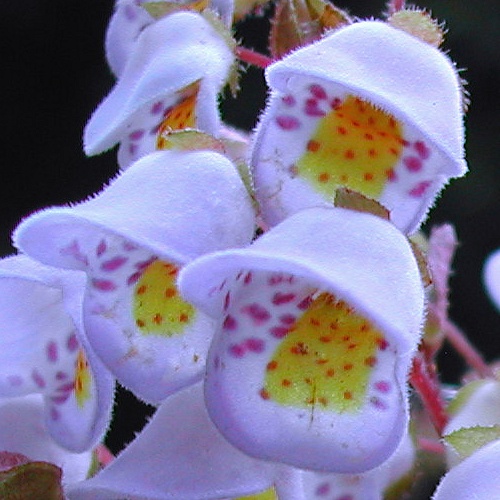Violet "Teacup Flower"
Germinating the seeds
If you have germinated Begonia seeds before, you may use the same technique that worked for you, since the germination requirements are similar. Getting started -- Plant your seeds when you receive them for best results. Use small pots or cups about 2-3 inches (5-10 cm) tall. Use containers with drainage holes. Use well-draining soil.
I use a mix of 1 part
coir fiber The seeds are tiny, so work in a well-lit area. Fill the pots with soil and sprinkle several seeds evenly across the surface of each pot. An easy way to pick up the seeds is by breathing on your finger tip to lightly moisten it, then dabbing the seeds with it. If you have
long-fibered sphagnum moss For the next few weeks, ensure that the soil surface never dries out. You can maintain high humidity by enclosing the pots in a plastic container or bag - just leave it open a crack to let in fresh air. Once or twice a day, drip a few drops of water on the surface to keep it moist. The seeds germinate well at about 65-77 degrees F (18-25°C).
Avoid letting them get warmer than this. I recommend placing a
minimum/maximum thermometer Place them in bright light out of direct sun. A bright LED or fluorescent bulb kept 4 inches (10 cm) away provides the right amount of light (See: "Growing indoors with LED lights"). They should start sprouting within about 3-5 weeks, but can sometimes take longer. After they sprout, continue dripping water on the soil surface for 2 months, since young seedlings have a small root system. When the seedlings are 2 months old, you may carefully pull them and transplant them, however i recommend simply cutting off any slower ones, and leaving 1 strong seedling in each pot. Fertilizing -- Feed weekly
with a small amount of dilute liquid fertilizer (1/8 strength).
Hydroponic fertilizer
is ideal for young seedlings, because it is easily absorbed and contains all
essential nutrients. After 3 months, you may switch to a granular fertilizer Watering -- Aim to keep the soil evenly moist (but not constantly soggy). Don't let the soil dry out completely. Lighting -- The plant likes part sun or bright shade + morning sun. Protect it from strong afternoon sun. Transplanting -- When the seedlings are 2 months old, repot to a larger container about 1 quart (1 liter) in size. Water the soil before repotting, to keep the soil ball from breaking apart, which can damage the roots. Protect from direct sun the first week after repotting. Climate -- It comes from regions of Chile that are cool all year. It seems happiest between 45 and 80 degrees F (7-27°C), with nights below 65° F (18°C). I don't know if it will thrive if temperatures regularly get above the low 80s (28°C) and nights are warm. Over about 40% humidity is best. If your plants seem to suffer from low humidity indoors, consider using an ultrasonic humidifier, sold at home improvement stores and some thrift shops. If you have any questions or problems, please contact me. Have fun growing them! - Jeff Strange Wonderful Things
|
|||||||||


